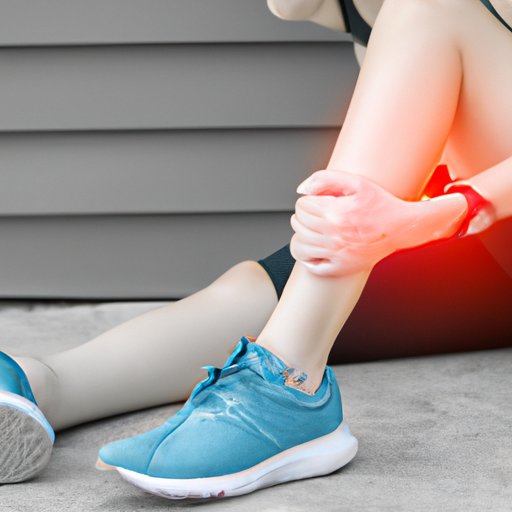Introduction
Exercising is an important part of maintaining a healthy lifestyle, but it’s not uncommon for people to experience muscle soreness after a workout. This post-workout muscle soreness is known as delayed onset muscle soreness (DOMS) and is the result of microscopic damage to the muscle fibers from exercise. In this article, we’ll explore what causes muscle soreness after working out, ways to prevent and minimize it, and tips for relieving it.
Definition of Muscle Soreness
Muscle soreness is the sensation of discomfort or pain that occurs after physical activity. It usually begins during or shortly after exercise and can last for several days. The exact cause of muscle soreness is still unknown, but some theories suggest that it is caused by microscopic tears in the muscle fibers due to the strain of exercise.

Overview of the Science Behind Muscle Soreness
When you exercise, your muscles are put under stress, causing microscopic tears in the muscle fibers. This initiates a process called “repair and remodeling,” which involves the body sending inflammatory molecules to the area to repair the damaged tissue and rebuild stronger fibers. This process is what causes the sensation of muscle soreness. According to a study published in the journal Sports Medicine, “The muscle response after exercise-induced muscle damage includes inflammation, which is thought to be responsible for the development of delayed onset muscle soreness.”
Ways to Prevent and Minimize Post-Workout Muscle Soreness
There are several ways to prevent or minimize muscle soreness after a workout. Here are a few tips:
Appropriate Warm-up and Cool-down Routines
It’s important to warm up before exercising and cool down afterwards. A proper warm-up will increase blood flow to the muscles, helping them to prepare for the upcoming activity. A cool-down period gives the muscles time to relax and recover after exercise. This can help reduce the amount of muscle soreness experienced.
Proper Form and Technique
Using proper form and technique while exercising is essential for preventing injury and minimizing muscle soreness. Make sure to use the correct posture and movement patterns for each exercise to ensure that your muscles are performing optimally and not being overworked.
Adequate Rest Between Workouts
Resting between workouts allows the body time to recover and repair the muscles that were used during the previous workout. This helps to reduce the amount of muscle soreness experienced. Aim to take at least one day off between workouts and make sure to get plenty of sleep each night.
Tips for Relieving Muscle Soreness After Working Out
If you do experience muscle soreness after a workout, there are several things you can do to help relieve the discomfort. Here are a few tips:
Use Heat or Cold Therapy
Applying heat or cold to the affected area can help reduce muscle soreness. Heat therapy increases blood flow to the area, which can help reduce pain and stiffness. Cold therapy reduces inflammation and can provide temporary relief from muscle soreness.
Light Exercise to Increase Blood Flow
Light exercise such as walking or stretching can help to increase blood flow to the affected area, reducing muscle soreness. Make sure to avoid any strenuous activities that could further aggravate the sore muscles.
Massage to Reduce Tension
Massage can be an effective way to reduce tension in the muscles and help relieve muscle soreness. Massage increases blood flow to the area and helps to break down any built-up lactic acid, which can reduce pain and stiffness.

Benefits of Muscular Soreness After Exercise
Although muscle soreness can be uncomfortable, it does have its benefits. When the body repairs the muscles after exercise, they become stronger and more resistant to future strain. This can lead to improved strength and endurance, increased flexibility, and a reduced risk of injury.
Different Types of Muscle Soreness
There are two main types of muscle soreness: delayed onset muscle soreness (DOMS) and acute muscle soreness. DOMS is the type of soreness that most people experience after a workout and typically occurs 12-24 hours after exercise. Acute muscle soreness is the immediate soreness felt during and immediately after exercise.

How Long Muscles Stay Sore After Exercise
The duration of muscle soreness depends on several factors, including the type and intensity of the exercise, the individual’s fitness level, and the amount of rest taken between workouts. DOMS usually lasts for 1-3 days, but may linger for up to 5 days depending on the severity of the muscle damage.
Relationship Between Intensity of Workouts and Muscle Soreness
The intensity of the workout has a direct effect on the amount of muscle soreness experienced. High-intensity exercises, such as weight lifting, running, or HIIT, can cause more muscle damage and thus lead to more severe muscle soreness. Low-intensity exercises, such as walking or yoga, typically cause less muscle soreness.
Conclusion
Muscle soreness is a normal part of exercise and can be beneficial if managed correctly. It’s important to warm up and cool down properly, use proper form and technique, and take adequate rest between workouts to minimize muscle soreness. Additionally, using heat or cold therapy, light exercise, and massage can help to relieve muscle soreness after a workout.
(Note: Is this article not meeting your expectations? Do you have knowledge or insights to share? Unlock new opportunities and expand your reach by joining our authors team. Click Registration to join us and share your expertise with our readers.)
